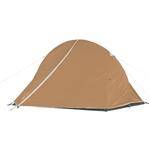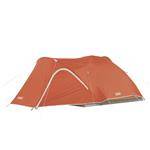When traveling, hiking, trekking, biking, or exploring the outdoors, you’ll generally need to consider your basics: food, water, and shelter to name a few. When it comes to shelter, the avid outdoorsman will consider many details that go into choosing the right one. From car camping to backpacking, there are several different styles and options for tents.
Whether you’re looking for a little privacy, shelter from a storm, or a base camp to utilize as a springboard for your other activities, your tent is a home base that should be carefully selected for your needs. Here’s the down and dirty on how to pick your home away from home.
Shop our extensive line of tents at Outdoor Shopping.
Design
We’ve all seen the tent that rivals the nearby hotel as well as its sleek, single-person counterpart. Tent designs range from one extreme to another, but there are a few areas of interest that can help you narrow your selection.
Anatomy
There are many working parts that make up a fully-functioning tent. While some tents may not include all of the extras, here are a few key features:
Cover Material : The sheltering part of your tent is a material - generally comprised of water-resistant fabrics like nylon or polyester. When you’re shopping, be aware that higher-denier fabric canopies and rainflys are more rugged than lower-denier ones. Also, seam tape and high-denier fabrics on tent floors reduce the odds of leakage. This fabric is manipulated further by other structural components such as the poles.
Peak Height : The interior of your tent can range from short and confining to tall and spacious. If you’re looking for a comfortable and roomy stay, then check the peak height statistics on your tent when you’re shopping.
Poles : The poles are what gives a tent it’s structure, and virtually all family tents nowadays are free-standing (meaning, they require no stakes to set up). Fewer poles allow for faster setups, and the composition of your poles can change your tent’s durability.
Aluminum: Stronger, more durable
Fiberglass: More common but more likely to bend and break
Doors : While more simplistic tents may include a single door, opt for tents with multiple doors if you’ll be camping with family or multiple group members to avoid having to crawl over one another to enter and exit the tent.
Rainfly : Expecting a rainy night? A rainfly is a separate waterproof cover designed to fit over the roof of your tent. Use it whenever rain or dew is expected, or any time you want to retain a little extra warmth. If you’re in harsher climates (like higher altitudes during alpine climbing), then opt for full-coverage rainflies. Otherwise, roof-only rainflys are sufficient for slight rain. As an added bonus, they allow more light into the tent.
Loops and Pockets : Often, a lantern loop is available top and center of the interior of your tent for - you guessed it - hanging your lantern. Additional loops on tent walls can be used to attach a mesh shelf (called a gear loft, sold separately) to keep small items off of the tent floor, and guy loops and guy lines on the exterior of your tent can be used to keep fabric tied down tightly during high winds.
Vestibules : These extendable sections of a tent's rainfly (requiring stakes and maybe a few guylines) create a sheltered zone outside your tent for stashing boots and other gear. Nearly all tents offer 1 or 2, though they can vary widely in size. Vestibule size is included in the tent specs.
Gear Loft : A gear loft is an optional interior mesh shelf that can tuck greater volumes of gear out of the way and is suspended with clips.
Size/Capacity
The group you plan to camp with will determine the first category: your tent’s size. Both car camping tents and backpacking tents will vary in capacity, and most tent names will include a number to delegate the capacity maximum (for instance, the tent pictured right is a Coleman Evanston Screened 6 Tent, meaning that it is rated for a capacity of 6). The best part about selecting appropriately-sized tents is that you don’t necessarily need one tent to do the job. Additional tents, overhangs, and storage areas can be added and connected to house gear, dogs, and even extra campers if needed.
To select the right size for your planned capacity, assume a close fit. Remember, the smaller the tent, the lighter the gear you’ll have to carry with you. There are a few instances where you may want to opt for a tent that is rated at one person larger than your expectations. Choose larger tents if you or a tentmate are:
Larger in stature
Claustrophobic
Toss and turn at night
If you are bringing a small child or dog with you on the trip and will be keeping them in your main tent, then opt for a tent capacity +1 to accommodate.
Weight
While weight may not be a factor for car camping, those who must lug their tent in a backpack for hiking or climbing will take weight into consideration. Solo tents range between 2 and 3 pounds while two-person tents commonly range from 3 to 5 pounds. Aim for a per-person weight of less than 3 pounds. Getting close to 2, or even less, is excellent. Realize, though, that a low per-person weight usually results in a snug interior (which may be great if you’re outdoors during colder weather!).
Style
There are two main styles when it comes to tents, and each style has its advantages and disadvantages based on your needs.
Cabin-Style Tents : These tents feature near-vertical walls to maximize overall peak height and livable space, making it a great choice for the casual camper who may have many tentmates. Some models even come with family-pleasing features such as room dividers and an awning, or a vestibule door that can be staked out.
Dome-Style Tents : These tents are designed for harsher weather conditions, making them ideal for climbers or hikers who may experience less-than-pleasant weather conditions. Keep in mind that the slanted roof cuts down on livable space.
Seasonality
All tents are not created equal, and some tents will hold up better in harsher conditions than others. Check out our chart to see which tent may be right for your needs:
Seasonality Rating | General Guidelines | Best for: |
3 Season Tents | Lightweight and good for spring-fall weather with no harsh conditions. Typically equipped with ample mesh for ventilation purposes. |
|
Extended Season Tents | Extends the seasonality to early spring and late fall when weather begins to falter. Offers a balance of ventilation, strength and warmth-retention. |
|
4 Season Tents | Also known as mountaineering tents, these tents are engineered to withstand fierce winds and substantial snow loads. |
|
All of our tents are listed with their seasonality. Choose the correct seasonality tent for your needs!
Shop our extensive line of tents at Outdoor Shopping.
Other Options
As with most camping items, there are many other options to consider than just the basics. Beyond size, weight, and seasonality, here are some additional details to consider when choosing your tent:
Floor Dimensions/Footprint
The floor of your tent is where you sleep and, thus, is of equal importance to the shelter overhead. The footprint is a custom-fitted groundcloth (usually sold separately) that goes under your tent floor to help prevent normal wear and tear while keeping out dampness.
Footprints are designed to fit the floor of your tent exactly, so the dimensions and shape of the floor of your tent will play a huge role. Tent floor plans show length and width measurements - usually in inches - but keep in mind that floor plans usually list only a tent's widest measurement which is at the shoulder of the tent. Also, tent floors come in a variety of shapes. From rectangle to hexagon to tapered, there’s a floor shape for all needs.
If you’re a taller camper, then select a tent with floor lengths measuring around 90" or higher, as the slope of the ceiling of standard tents will make it uncomfortable for those who are above average in height.
Also, keep in mind that two tents may offer identical floor dimensions but can claim different square footage. This is because the tent with the smaller floor area number most likely tapers more narrowly at the foot end. So while floor-level space is of some importance, you’ll want to take it in conjunction with other measurements like peak height.
Fabric Composition
Tent fabric is traditionally either nylon or polyester, and the weight of tent fabrics is expressed in denier (D), a measurement of a yarn's weight (in grams) based on a 9,000-meter (5.6-mile) length of that yarn. Higher numbers indicate coarser, more rugged fabric; lower numbers reflect a lighter, finer material.
For alpine climbers or campers traversing in rugged conditions, a sturdier and more durable fabric is ideal such as nylon. Casual hikers and campers can benefit from the weight reduction of a lighter material like polyester, although you’ll sacrifice much of the durability that you’d get with nylon. If you’re a backpacker opting for an ultralight tent, then be sure to take your footprint with you to prevent floor wear and tear.
Tent Color
This may seem secondary, but for anyone who has been forced to shelter themselves inside their tent for long durations or during a dark storm, they’ll tell you that a brighter tent can make a world of difference with the interior lighting. Traditionally, rainflys have featured muted earthtones in order to remain unobtrusive and minimize visual impact on the surrounding scenery for other visitors. Consider a reflective tent if you know you’ll be facing harsher conditions as well.
Accessories
Technology has come a long way when it comes to tents, and there are now many accessories that can make your camp-out a little more comfortable:
Stakes and anchors for varying site conditions
Broom and dustpan
Inside/outside floor mat
Tent repair kit
Seam sealer
Utility cord
Battery-powered ventilation fan





